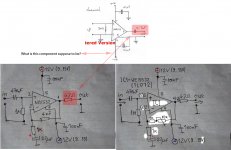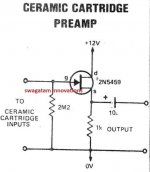Hi all,
As the title suggests I would like to connect a ceramic cartridge to a standard line level input on a modern solid state amp. I do not need RIAA equalization. On the thread https://www.diyaudio.com/community/threads/ceramic-pickup-preamp-schematic-needed.175822/ I found a circuit (attached) but I thought that I would touch base to see if this circuit is still valid. Also if anyone could tell me what that mystery component is.
Thanks
As the title suggests I would like to connect a ceramic cartridge to a standard line level input on a modern solid state amp. I do not need RIAA equalization. On the thread https://www.diyaudio.com/community/threads/ceramic-pickup-preamp-schematic-needed.175822/ I found a circuit (attached) but I thought that I would touch base to see if this circuit is still valid. Also if anyone could tell me what that mystery component is.
Thanks
Attachments
The upper part is a 4.7uF cap and is used to block any DC offset from the opamp.
The lower left one is a 47 ohm resistor and is used to aid stability connecting the opamp to slightly capacitive loads. That circuit also needs a cap as the offset will be horrendous with the other component values shown.
Edit... the TL072 version will not suffer DC offset with it being a FET opamp but a coupling cap is always a good idea.
The lower left one is a 47 ohm resistor and is used to aid stability connecting the opamp to slightly capacitive loads. That circuit also needs a cap as the offset will be horrendous with the other component values shown.
Edit... the TL072 version will not suffer DC offset with it being a FET opamp but a coupling cap is always a good idea.
Educated guess: I expect a TL072 to be more suitable than an NE5532 or INA217 because of its lower equivalent input noise current. It could also be that it doesn't matter at all because of the relatively high level coming out of the cartridge.
Dedicating a specific line-level input to an amp for ceramic cartridges is usually easy.
Simply make sure the input is loaded internally with at least a 470K ohm or higher resistor.
No real need to "preamp" if the cartridge's output is around 200 to 500 mV.
Simply make sure the input is loaded internally with at least a 470K ohm or higher resistor.
No real need to "preamp" if the cartridge's output is around 200 to 500 mV.
Would you mind throwing a circuit sketch together?Dedicating a specific line-level input to an amp for ceramic cartridges is usually easy.
Simply make sure the input is loaded internally with at least a 470K ohm or higher resistor.
No real need to "preamp" if the cartridge's output is around 200 to 500 mV.
In order to do that, I'd have to see a schematic of the amp in question.Would you mind throwing a circuit sketch together?
You never told us what it is. - make, model.
Or at least a photo of the schematic's front end circuitry would help.
Be aware that 5532 and TL 072 need different in and out resistances, you will need to experiment.
And sound quality is better at around 15V compared to 9V, bear that in mind.
I used a false earth, to split the supply, it was +/- 8 or so, for total 15-16 Volts.
Also connect turntable, amp and circuit grounds together.
These were copied from the net, not my work, I hope nobody takes offense.
All well and nice.View attachment 1050320
View attachment 1050321
View attachment 1050322
View attachment 1050323
View attachment 1050324
Be aware that 5532 and TL 072 need different in and out resistances, you will need to experiment.
And sound quality is better at around 15V compared to 9V, bear that in mind.
I used a false earth, to split the supply, it was +/- 8 or so, for total 15-16 Volts.
Also connect turntable, amp and circuit grounds together.
These were copied from the net, not my work, I hope nobody takes offense.
However, those diagrams are not designed for a Ceramic Phono Cartridge, which this thread is about.
Ceramic cartridge output level 150-300 mV, MM/MC are much lower at 15-25 mV, IIRC.
So the gain in the above circuits will have to be changed to suit your amp.
So the gain in the above circuits will have to be changed to suit your amp.
The gain and input impedance and in one case the frequency response are not suitable for ceramic cartridges.
The traditional way to use ceramic cartridges is with a high load impedance and no RIAA correction, like the circuits earlier in this thread. An alternative is a charge amplifier, that is, a virtual ground load and a -20 dB/decade correction. I never tried that, but rumour has it that it works better than the traditional method.
The traditional way to use ceramic cartridges is with a high load impedance and no RIAA correction, like the circuits earlier in this thread. An alternative is a charge amplifier, that is, a virtual ground load and a -20 dB/decade correction. I never tried that, but rumour has it that it works better than the traditional method.
Last edited:
We still don't know the amplifier in question here.
I certainly can't drive a car with a blindfold on, can you?
I certainly can't drive a car with a blindfold on, can you?
Nothing special about the amp. Standard modern solid state amp/pre-amp with standard RCA unbalanced line level inputs (example: CD player)In order to do that, I'd have to see a schematic of the amp in question.
You never told us what it is. - make, model.
Or at least a photo of the schematic's front end circuitry would help.
Nothing special about the amp. Standard modern solid state amp/pre-amp with standard RCA unbalanced line level inputs (example: CD player)We still don't know the amplifier in question here.
I certainly can't drive a car with a blindfold on, can you?
Yes, but simple as it may be, it is still more complicated than wiseoldtech's proposal to change one resistor in the amplifier (for which a schematic of the amplifier is needed, to see which resistor needs changing and whether it can be changed without causing some problem or other).Would this do what I want?
Last edited:
But it's a modern solid state amp. Presumably (and not unreasonably) the op doesn't want to hack it.
A ceramic cartridge was often used with valve equipment which has a high input impedance.
Typically a turntable would be plugged into the aux sockets of a valve radio.
High input impedance with a ceramic cartridge means no equalization filter required.
The op can build a simple high input impedance buffer / preamp as he has suggested.
He can then use it with any amplifier.
While it can be good to explore all options it is not always helpful.
A ceramic cartridge was often used with valve equipment which has a high input impedance.
Typically a turntable would be plugged into the aux sockets of a valve radio.
High input impedance with a ceramic cartridge means no equalization filter required.
The op can build a simple high input impedance buffer / preamp as he has suggested.
He can then use it with any amplifier.
While it can be good to explore all options it is not always helpful.
That would be perfectly reasonable, but it's not the impression I get from post #5. Anyway, it's up to the OP to decide what he, she or it wants.
I'm sorry that I was not more clear. I want to have a circuit that would allow me to connect a ceramic cartridge to "any" line level input device. Examples would be an audio amplifier, video receiver, computer sound card, and Mini DSP.
Maybe the single FET could be an option as it gets you pretty much any input impedance you want and could be made to run from a 9v battery.
I do remember many years ago a dedicated preamp appearing in Wireless World and it was designed to get the very best possible performance from ceramics and was reputed (using some of the best cartridges) to rival some top moving magnet cartridges and preamps. Everything hinged on getting the loading correct, very high impedance but I recall there was more to it than just that.
I do remember many years ago a dedicated preamp appearing in Wireless World and it was designed to get the very best possible performance from ceramics and was reputed (using some of the best cartridges) to rival some top moving magnet cartridges and preamps. Everything hinged on getting the loading correct, very high impedance but I recall there was more to it than just that.
- Status
- Not open for further replies.
- Home
- Source & Line
- Analogue Source
- Ceramic cartridge to line level input circuit

